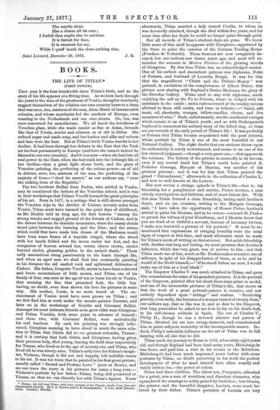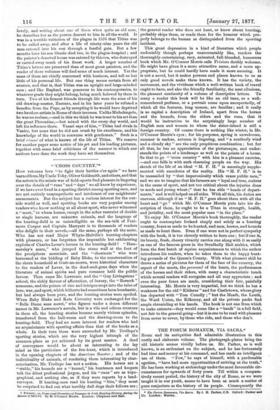BOOKS.
THE LIFE OF TITIAN.*
(FIRST NOTICE.)
Tins year is the four-hundredth since Titian's birth, and so the story of his life appears at a fitting time. As we look back through the years to the time of the greatness of Venice, thoughts inevitably suggest themselves of the relation our own country bears to a State that was once, too, mistress of the seas, Alma Mater of innumerable colonies, and whose merchants fed the markets of Europe, even .coasting to the Netherlands and our own shores. She, too, was once renowned for manufacture. We all know the loveliness of Venetian glass, while she made camlet as fine as Asian, brocade like that of Persia, scarlet and crimson as of old in Sidon. She refined sugar and made soap, and her leather and silks and velvets and lace were the best. But at Titian's birth Venice was far in her decline. It had been through her defeats in the East that the Turk set his foot permanently in Europe (and here she cannot indeed be likened to our own country). And it was now—when she had lost all real power in the East, when she had sunk into the lethargic life of her decline—that a great light shone forth, and the glory of Venetian painting, the perfecting of the colour-power—as of old in Athens, once, too, mistress of the seas, the perfecting of the majesty of form—" shed its sunset," as our authors say, "over the sinking form of the Republic."
The two brothers Bellini from Padua, who settled in Venice, may be considered the fathers of the Venetian school, and it was in their workshops that Titiano Vecelli learned the great principles of his art. Born in 1477, in a cottage that is still shown amongst the Venetian Alps in the district of Cadore, seventy miles from Venice, Titian must have learned in the quiet days of childhood, -as Mr. Ruskin told us long ago, his first lessons "among the strong trunks and rugged ground of the forests of Cadore, and in the dawns between its desolate mountains, when the massy clouds stood quiet between the burning and the blue ; and the statue which could first have made him dream of the Madonna would have been some fresco of a wayside chapel, where she stood with her hands folded and the moon under her feet, and the companies of heaven around her, crown above crown, circlet beyond circlet, gleaming golden in the arched shade." These early associations clung passionately to his heart through life, and when an aged man we shall find him constantly painting in his distance the old castled rock and splintered dolomites of Cadore. His father, Gregorio Vecelli, seems to have been a shrewd and brave mountaineer of little means, and Titian, one of his family of four, was sent at the age of ten to learn his art in Venice, that seeming the line that promised best, the little boy -having, no doubt, even then shown his love for pictures in some way. His mother, Lucia, is no more heard of. The en- chantment of Venice must have soon grown on Titian ; and we first find him at work under the mosaic-painter Zuccato, and later on in the workshops of Gentile and Giovanni Bellini. Amongst his most intimate friends as he grew older were Giorgione -and Palma Vecchio, both some years in advance of himself ; and these two, with Giovanni Bellini, were undoubtedly his real teachers. By each his painting was strongly inilu- -enced, Giorgione seeming to have stood in much the same rela- tion to Titian that Girtin did to our greatest colourist, Turner ; and it is curious that both Girtin and Giorgione, having given their precious help, died young, leaving the field clear respectively for Turner, who lived on to the age of seventy-six, and Titian, who
lived till he was ninety-nine. Titian's early love for Palma's daugh- ter, Violante, though it did not end happily, left indelible traces in his art. It was her form that he painted in his first great picture, usually called "Sacred and Profane Love" (now at Rome), and we can trace the story in his pictures for many a long year,—
Tiolante's portrait by her father, Palma, being still preserved at -Vienna, so that we can identify her with Titian's figures. Years
* Titian ; his We and Times, with some Account of his Family, chiefly' from New and
Unpublished Records. By J. A. Crowe and G. B. Cavaleaselle. 2 vole, with Dluatra- Siona London: Murray.
afterwards, Titian married a lady named Cecilia, to whom he was devotedly attached, though she died within five years, and for some time after her death he could no longer paint through grief.
But all records of Titian's student-days are gone. We know little more of him until he appears with Giorgione—appointed by the State to paint the exterior of the German Trading House (Fondaco de Tedesehi). These frescoes are now completely de- cayed, but our authors saw traces years ago, and most will re- member the account in Modern Painters of the glowing wrecks of Giorgione. By this time Titian was an acknowledged master. One of his earliest and staunchest patrons was Alphonso, Duke of Ferrara, and husband of Lucretia Borgia. It was for him that the magnificent "Christ and the Tribute-Money" waif painted, in emulation of the completeness of Albert Ditrer, this picture now sharing with Raphael's Sistine Madonna the glory of the Dresden Gallery. Titian used to stay with Alphonso, much enjoying the sail up the Po to Ferrara, where he lodged with his assistants in the castle ; and a curious record of the weekly rations allotted to them still exists, and runs as follows :—" Salad, salt meat; oil, chestnuts, oranges, tallow-candles, cheese, and five measures of wine." Such, unfortunately, are the accidental vestiges which remain to Us of Titian's youth, and as with Shakespeare's boyhood is connected the solitary story of the killed stag, so these are our records of the early period of Titian's life ! It was probably at Ferrara that Titian became acquainted with the poet Ariosto, whose portrait by Titian is one of the most beautiful in our National Gallery. The slight doubt that our authors throw upon its authenticity is surely unwarranted, and seems to us one of the few errors of judgment,—though a very grave one,—that appears in the volumes. The history of the picture is assuredly in its favour, even if any mortal hand but Titian's could have painted it. Federico Gonzaga, Marquis of Mantua, was another of his greatest patrons ; and it was for him that Titian painted the grand "Entombment," afterwards in the collection of Charles L, and now so well known at the Louvre.
But now occurs a strange episode in Titian's life—that is, his friendship for a pamphleteer and satirist, Pietro Aretino, a man utterly unscrupulous and faithless, and of most vicious life. With this man Titian formed a close friendship, lasting until Aretino's death, and on one occasion, writing to the Marquis Gonzaga, said, "I have taken the opportunity of Messer Pietro Aretino's arrival to paint his likeness, and as he comes—a second St. Paul— to preach the virtues of your Excellency, and I likewise know that you are fond of so faithful a servant, because of his many virtues, I make you herewith a present of his portrait." It must be re- membered that expressions of cringing humility were the usual signs of respect at this time, and much allowance must be made for Titian's mode of writing on that account. But as his friendship with Aretino was long and lasting, we must presume that Aretino's influence, which was very great, was of service to him ; and that Titian made use of him, much as Mr. Ruskin makes extensive use of railways, in spite of his disapprobation of them, or as he said he would of the Devil himself,—" If he stood before me now, I would make use of him as a local black !"
The Emperor Charles V. was much attached to Titian, and gave him commissions for some of his grandest pictures. It is the portrait of the Empress, painted after her death from some print or medal, and one of the memorable pictures of Titian's life, that shows us that the work of a great portrait-painter is creative, and not entirely dependent upon " sittings " and realism. "Rendering gravely, even sadly, the features of a woman turned of twenty-four," our authors say, that so like was it, and so dear to the Emperor, that long years after he asked to see it as he lay on his death-bed, in his self-chosen solitude in Spain. The son of Charles V., Philip II., though he was a devoted admirer and patron of Titian, diverted his art into wrong channels, and commissioned
him to paint subjects unworthy of the incomparable master. In- deed, Philip's miserable influence on the art of Titian was in full keeping with all else that he did.
Titian made the journey to Rome in 1545, when sixty-eight years old, and though Raphael had been dead many years, Michelangelo was there, and paid him a visit in his rooms at the Belvidere. Michelangelo had been much impressed years before with some portraits by Titian, no doubt perceiving in his work the perfect development of what he must himself have often wearily and vainly striven for,—the power of colour.
Titian had three children. The eldest son, Pomponio, educated for a priest, was a man of worthless and dissolute character, who squandered the earnings so nobly gained by his father ; but Orazio, the painter, and the beautiful daughter, Lavinia, were much be- loved by their father. Titian's portraits of Lavinia are very
lovely, and writing about one of them when quite an old man, he describes her as the person dearest to him in all the world. It was in a terrible visitation of the plague in 1576 that Titian was to be called away, and after a life of ninety-nine years the old man entered into his rest through a fearful gate. But a few months later his son Orazio died too, in the plague-hospital ; and the painter's deserted house was entered by thieves, who destroyed or carried away much of his finest work. A larger number of Titian's letters are preserved than of most great painters, and the reader of these volumes will find some of much interest. Yet the mass of them are chiefly concerned with business, and tell us but little of his personal life. But one thing seems certain from all sources, and that is, that Titian was an upright and large-minded man ; and like Raphael, was generous to his contemporaries, to whatever grade they might belong, being much beloved by them in turn. Two of his firmest friends through life were the sons of his old drawing-master, Zuccato, and in his later years he refuted a benefice from the Pope, as by accepting it he would have deprived two brother-artists in Rome of their incomes. Unlike Michelangelo, he was no recluse,—and in this we think he was truer to his art than the great Florentine,—but mixed with the every-day world, and left his influence there. Vasari says of him, "Titian had rivals in Venice, but none that he did not crush by his excellence, and his knowledge of the world in converse with gentlemen." Such is a brief résumé of what is known of the life of Titian. We reserve for another paper some notice of his ert and his leading pictures, together with some brief criticisms of the manner in which our authors have done the work they have set themselves.



































 Previous page
Previous page